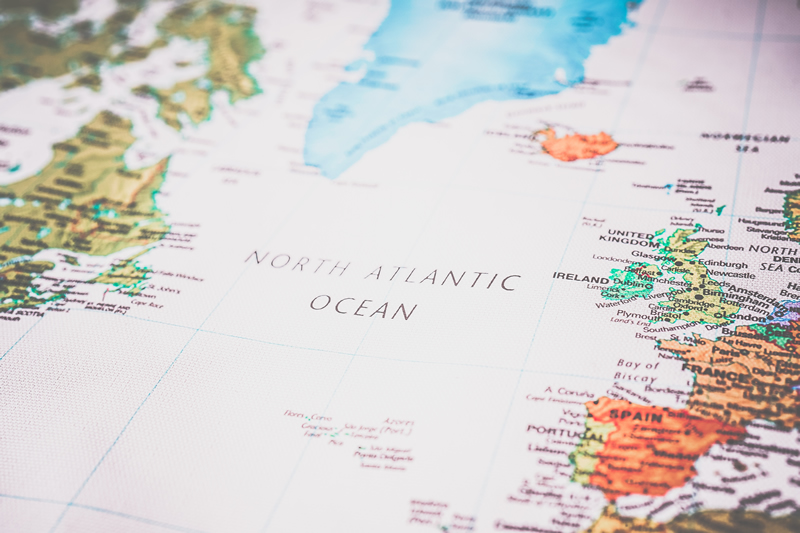North Atlantic Shipping Emission Control Zone Proposed
16
Designating a North Atlantic Emission Control Area (ECA) could yield substantial environmental and public health benefits, according to a new analysis by the International Council on Clean Transportation (ICCT). The report highlights how such a zone could prevent thousands of premature deaths by reducing harmful emissions from shipping in the region.

The Case For A North Atlantic ECA
As one of the world’s busiest shipping routes, the North Atlantic sees significant daily traffic from cargo vessels, tankers, and cruise ships. International shipping is a major source of pollutants such as sulfur oxides (SOx), particulate matter (PM), and nitrogen oxides (NOx). These emissions are linked to health problems, including premature deaths, and contribute to environmental damage affecting marine ecosystems, critical marine mammal habitats, and culturally significant areas.
To mitigate these impacts, the establishment of an ECA could enforce stricter regulations on shipping emissions. A previous ICCT assessment found that implementing a North Atlantic Emission Control Area (AtlECA), covering the territorial seas and exclusive economic zones of the Faroe Islands, France, Greenland, Iceland, Ireland, Portugal, Spain, and the United Kingdom, could significantly reduce shipping emissions by 2030. Additionally, the AtlECA would bridge existing ECAs in the Baltic, North, and Mediterranean Seas with newly approved ECAs in the Norwegian Sea and Canadian Arctic.
Population & Port Cities In The AtlECA Region
The proposed AtlECA encompasses a population of approximately 193 million people, with over 90% residing in France, Spain, and the United Kingdom. While most member states are projected to experience population growth from 2021 to 2030 and 2050, Portugal, Spain, and Greenland are expected to see gradual declines. Major port cities within the region include Lisbon, Porto, Dublin, Liverpool, and Bilbao, which are hubs of shipping activity and air pollution hotspots.
Protecting Marine Biodiversity & Cultural Sites
Beyond public health, the AtlECA could play a vital role in preserving marine biodiversity and cultural heritage. The proposed zone includes over 1,500 marine protected areas, 17 important marine mammal habitats, and 148 UNESCO World Heritage sites. Reducing SOx and NOx emissions from shipping would help mitigate pollutant deposition and ocean acidification, benefiting ecosystems and safeguarding these significant sites.
The Potential Impact Of An AtlECA
Although member states have implemented land-based air quality measures that have improved air quality in most regions, shipping remains a significant, under addressed contributor to air pollution. According to ICCT’s analysis, establishing the AtlECA could reduce shipping-attributable SO2 concentrations by 86%, PM2.5 by 59%, and NO2 by 3% in the region. It could also halve population-weighted exposure to PM2.5 from shipping emissions in the median member state by 2030.
Conclusion
Establishing a North Atlantic Emission Control Area offers a practical and effective strategy to address the environmental and public health challenges posed by shipping emissions. By reducing harmful pollutants, the AtlECA could protect vulnerable populations, preserve marine biodiversity, and safeguard cultural and natural heritage sites while fostering sustainable development in the region.
#Protea #Emissions #Monitoring #CEMS #FTIR #Gas #Analysers #Shipping #Marine #Carbon #Capture
Other Articles
Global Underground CO2 Storage Data Offers Hope Amid Rising Emissions
01
IMO Postpones Adoption Of Global Net-Zero Shipping Framework
04
Pioneering Carbon Capture Projects Ready For Construction
03
Methanol & Ammonia Deemed Ready As Zero-Emission Shipping Fuels
01
Carbon Capture Storage Reaching A Turning Point In Decarbonisation
13
CCS To Capture 15% Of Shipboard Carbon Emissions By 2050
29
Global Shipping Industry Struggles To Navigate Net Zero Transition
21
Carbon Capture Surges as Economics Policy & Industry Demand Align
14
GHG Emissions At Ports On The Rise Despite Initiatives
07
Carbon Capture Utilisation & Storage In A Nutshell
30